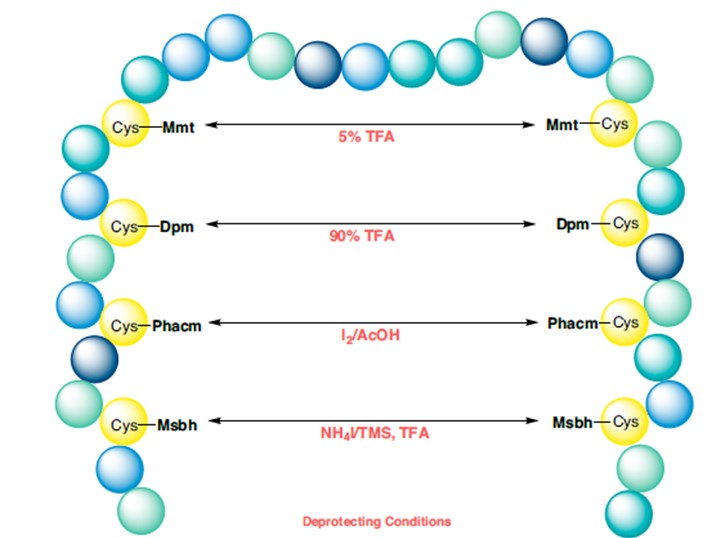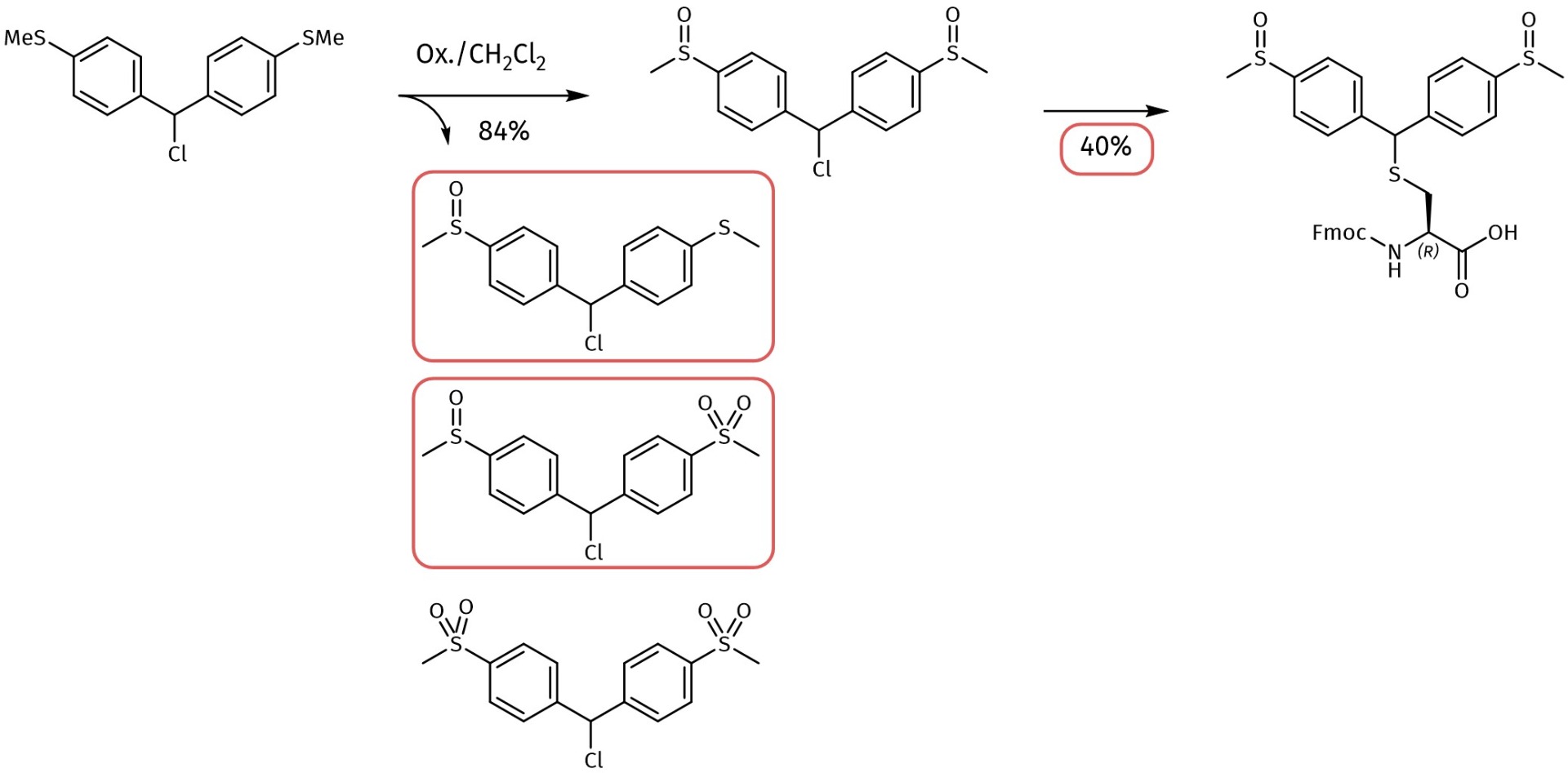Welcome to Iris Biotech
For better service please confirm your country and language we detected.

For better service please confirm your country and language we detected.

Thank you very much for your interest in our products. All prices listed on our website are ex-works, Germany, and may attract customs duties when imported.
You may/will be contacted by the shipping company for additional documentation that may be required by the US Customs for clearance.
We offer you the convenience of buying through a local partner, Peptide Solutions LLC who can import the shipment as well as prepay the customs duties and brokerage on your behalf and provide the convenience of a domestic sale.
Continue to Iris Biotech GmbHSend request to US distributorPublished on 03.10.2023

In 1991, Michal Lebl et al. published 4,4-bis(dimethylsulfinyl)benzhydryl (Msbh) as new Cysteine “safety-catch protecting group” providing an additional orthogonality, thus enabling efficient and targeted synthesis of peptides with four or more disulfide bridges. Besides, Msbh is also useful whenever the presence of free thiols and their high nucleophilicity is interfering with the development of a robust process.
Msbh is stable towards acidic (TFA, HF), oxidative, and reductive conditions until its electron-withdrawing sulfoxide groups are reduced. Upon reduction, the formed sulfide renders the bond between the cysteine sulfhydryl group and the benzylic carbon of the Msbh group acid-labile and thus facilitates deprotection using TFA. Both steps can be performed in a one pot reaction using NH4I/DMS/TFA. The innovative Msbh protecting group is stable to the deprotection conditions of most common cysteine PGs such as Mmt, Trt, Acm, or Phacm. Moreover, it is stable to conditions applied both in Boc and Fmoc chemistry.

Msbh provides an additional level of orthogonality and facilitates consecutive disulfide bond formation.
The published route of synthesis for Fmoc-Cys(Msbh)-OH starts with cleverly chosen raw materials and consists of five-steps. However, if considered for multi kg scale and industrial application, this route bears certain challenges and needs to be analyzed carefully:
1. Often, fluorinated starting materials are rather expensive. Fortunately, the starting material 4,4-difluorobenzophenone is rather affordable.
2. In the next step the benzophenone moiety is being reduced to the benzhydryl alcohol. However, overreduction might lead to the hydrocarbon. Thus, careful monitoring of the process is required allowing to optimize the reaction yield.
3. In a next step, the alcohol function is transformed into a chloride using thionyl chloride in dichloromethane (CH2Cl2). For environmental reasons, the use of halogenated solvents should be avoided.
4. Both thioethers are oxidized to the corresponding sulfinyl groups by meta-chloroperoxybenzoic acid. It is of high importance to avoid overoxidation to the sulfon or bis-sulfon derivatives, as such cysteines cannot be deprotected anymore once incorporated in a peptide sequence. Sophisticated purification methods allow to remove these impurities. Besides, this step also involves the use of CH2Cl2, a halogenated solvent, which should rather be exchanged by an ecologically friendly solvent.
5. For the last step – the attachment of Cysteine and Fmoc protection – only poor yields are reported. Especially this step needs to be optimized for large scale production.


Published route of synthesis for Fmoc-Cys(Msbh)-OH. Undesired side-products, reagents and hurdles are highlighted in red.
In the following table, we compare the initially published route of synthesis with the one after process development.
|
Step |
Conditions |
Yield |
Conditions |
Yield |
Purity |
|
|
Published route of synthesis |
After process development |
|||
|
2 |
THF, methanol and water |
95% |
Different solvents and mixtures |
100% |
98% |
|
3 |
CH2Cl2, Et2O, n-hexane |
82% |
“Green” solvents, only |
90% |
>99% |
|
4 |
CH2Cl2, H2O |
84% |
CH2Cl2, H2O; |
80% |
>98% |
|
5 |
CH2Cl2, H2O, dioxane; |
40% |
CH2Cl2, H2O, dioxane; |
54% |
>99% |
Our experienced chemists can support you in bringing your synthesis from discovery to commercial scale and will provide the following assistance:
a) Repeating your route of synthesis, yield determination and impurity profiling.
b) Systematic evaluation and optimization of each reaction step, e.g., via screening of different solvents, reagents, and additives, as well as reaction temperatures.
c) Focus on “green” chemistry.
d) Technology transfer to the production site of your choice.
→ For detailed information about the unique properties of the Msbh protecting group, check out our previous blogs about “Msbh, a Safety Catch Cysteine Protecting Group for the Synthesis of Cyclic Peptides” and “PotM: Fmoc-Ser(Msbh)-OH”
→ For more information about our custom synthesis capabilities, download our brochure or get in contact for scale up from R&D to bulk quantities
References:
Total synthesis of human hepcidin through regioselective disulfide-bond formation by using the safety-catch cysteine protecting group 4,4'-dimethylsulfinylbenzhydryl; Z. Dekan, M. Mobli, M. W. Pennington, E. Fung, E. Nemeth, P. F. Alewood; Angew Chem Int Ed Engl 2014; 53: 2931-4. https://doi.org/10.1002/anie.201310103
A new safety-catch protecting group and linker for solid-phase synthesis; S. Thennarasu, C.-F. Liu; Tetrahedron Lett 2010; 51: 3218-3220. https://doi.org/10.1016/j.tetlet.2010.04.047
Safety-catch and multiply cleavable linkers in solid-phase synthesis; M. Pátek, M. Lebl; Biopolymers 1998; 47: 353-363. https://doi.org/10.1002/(sici)1097-0282(1998)47:5<353::Aid-bip3>3.0.Co;2-i
A reductive acidolysis final deprotection strategy in solid phase peptide synthesis based on safety-catch protection; T. Kimura, T. Fukui, S. Tanaka, K. Akaji, Y. Kiso; Chem Pharm Bull (Tokyo) 1997; 45: 18-26. https://doi.org/10.1248/cpb.45.18
Safety-catch anchoring linkage for synthesis of peptide amides by Boc/Fmoc strategy; M. Pátek, M. Lebl; Tetrahedron Lett 1991; 32: 3891-3894. https://doi.org/10.1016/s0040-4039(00)79406-8
The p-(methylsulfinyl)benzyl group: a trifluoroacetic acid (TFA)-stable carboxyl-protecting group readily convertible to a TFA-labile group; J. M. Samanen, E. Brandeis; J. Org. Chem. 1988; 53: 561-569. https://doi.org/10.1021/jo00238a016